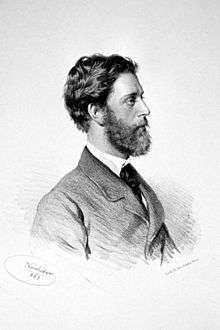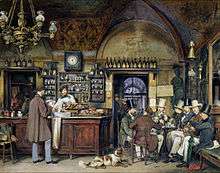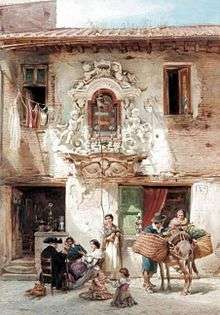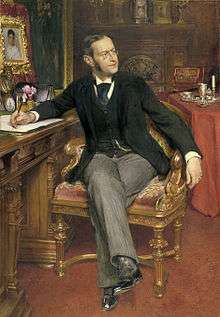Ludwig Passini
| Ludwig Johann Passini | |
|---|---|
 Ludwig Passini, Lithography by Josef Kriehuber | |
| Born |
9 July 1832 Vienna |
| Died |
6 November 1903 (aged 71) Venice |
| Education | Vienna Academy of Art |
| Known for | watercolour and oil painting, printmaking |





Ludwig Johann Passini (1832–1903) was an Austrian narrative and genre painter and printmaker.
Personal life
Ludwig Passini was born on 9 July 1832 in Vienna, the son of the engraver Johann Nepomuk Passini[1] – the Passini family moved to Trieste in 1850. On 9 November 1864 Passini married Anna Warsaw (1841-1866) at Berlin, she the daughter of Robert and Mary Warschauer, the great-granddaughter of banker Joseph Mendelssohn and the great-great-granddaughter of philosopher Moses Mendelssohn. The couple, who lived alternately in Berlin and Rome, had one daughter. Anna died one and a half years after the wedding.
Ludwig Passini died on 6 November 1903 in Venice.
Career

Passini was taught art first by his father, and later studied at the Vienna Academy of Art under the painters Joseph von Führich and Leopold Kupelwieser.[1][2] In the 1850s Passini settled in Venice where he worked in the studio of Carl Werner, under whom he had previously studied at Leipzig[1] – he accompanied Werner on his painting tour of Italy.[2][3] The fellow artist Anton Romako was also part of Werner's studio. Between 1853 and 1870 Passini lived in Rome, where his work became focused on the human figure set against architectural and interior elements, and within narrative themes. From 1873, and for the rest of his life, he remained in Venice – though with occasional visits to Berlin – where his watercolours often featured everyday Venetian life, ordinary people, and portraiture.[4]
While in Venice, Passini became part of the artist colony of Henry Woods, August von Pettenkofen, Carl van Haanen, Eugene de Blaas, Wolkoff, Ruben, and Thoren.[5] Passini occupied a studio in the Palazzo Vendramin Calergi – this for thirty years – with fellow artists Carlo Reichardt and Luigi Mion. While here, in 1892, he painted his portraits of Katherine Bronson and Edith, her daughter, and the English Under-Secretary of State for Foreign Affairs and art historian Sir Henry Layard.[4] A further two 1892 portraits were of the American art collectors Jack Gardner (also a businessman), and his wife Isabella (founder of Fenway Court art museum), who lived at the Palazzo Barbaro. Isabella had commissioned the paintings after meeting Passini at a dinner party held by Katherine Bronson. The portrait of Isabella was not successful and does not survive.[6][7]
A friend of Passini was the exiled Richard Wagner, who died at Vendramin Calergi in 1883. Passini, and fellow painter Wolkoff, suggested a death mask for Wagner, the idea at first rejected by Wagner's wife Cosima, but carried out by Passini and the sculptor Augusto Benvenuti under the agreement, and eye, of Cosima's daughter, Daniela.[8]
The first Venice Biennale was held in 1895 as an exhibition of specifically Italian art. In formulating the Biennale in 1893 the mayor of Venice, Riccardo Selvatico, was advised by a committee of internationally exhibiting artists from many European countries, one being Ludwig Passini.[9]
Passini received medals in Paris (1870), Vienna (1873), Munich (1879), and Berlin (1896). His works were included in exhibitions at the Royal Academy and the Royal Institute of Painters in Water Colours in London, and he became an honorary member of the latter in 1883. Passini was awarded the Bavarian Order for Science and Art in 1893.[1]
In 1878 Passini was made a Knight of the Legion of Honour,[1] and the following year an honorary professor of the Vienna Academy of Art. He was also a member of the Academy of Arts, Berlin and the Academy of Arts, Venice.[10]
Reception
Passini exhibited in the Italian Fine Arts Section of the 1878 Paris Exposition Universelle. The art critic Philip Gilbert Hamerton described Italian painting of the time as playful to the point of being childish, although original with direct observation of nature. Passini's work for the Exposition was considered by critics to have saved the quality of Italian art shown.[11]
The Viennese author and critic Ludwig Hevesi believed Passini "the major watercolour painter of Venice... who grew rapidly to be the most important genre painter."[12]
Art historian Wilhelm Lübke described Passini's work: "Admirable character-pictures of Southern life may be found in the masterly watercolours of Ludwig Passini, with their beautifully-finished colouring."[13]
The 19th-century arts magazine The Aldine in 1878 described Passini's pictures as "showing a skill in studying the human face, and an appreciation of its expressions, which indicate natural gift even more than close study... [and] the careful drawing and skillful posing of... figures."[14]
Works (selected)
- Monks Buying Fish at the Portal of the Madonna della Misericordia (1855)
- Salone of the Palazzo Barbaro (1855)
- Cafè Greco in Rome (1856), Kunsthalle Hamburg[15]
- Roman Fish Market at Sant'Angelo in Pescheria (1863)
- The confessional (1863)
- The interior of the Basilica of Santa Maria Maggiore (1867)
- The Latin Class (1869)
- A Shared Confidence (1870)
- Praying in a Venetian church (1873)
- Bridge at the Riva degli Schiavoni - A Procession in Venice (1873-74)
- People on a Venetian canal (1893)
- A Clerical Intervention (1897)
References
- 1 2 3 4 5 "Ludwig Johann Passini, 1832-1903", The Correspondence of James McNeil Whistler, University of Glasgow, Retrieved 29 January 2014
- 1 2 Wawrik, Franz; Zeilinger, Elisabeth (1989); Österreich auf alten Karten und Ansichten, Akademische Druck- u. Verlagsanstalt, p.362. ISBN 3201014761
- ↑ Kashey, Robert; Reymert, Martin L. H. (1981); German drawings and watercolors, 1780-1880 (a survey of works on paper by German-speaking artists), Shepherd Gallery, Associates, New York City, p.100
- 1 2 Adelson, Warren (2006); ’’Sargent's Venice’’, Yale University Press, pp.185, 196. ISBN 0300117175. Quoting Vardui Kalpukcian: "Ludwig Passini (1832, Vienna - 1903, Venezia): un pittore austriaco, ritrattista della vista Venezia" in Roemische Historische Mitteilungen, ed. Richard Borsel and Herman Fillitz, vol 46, Roman Historical Releases 46th Austrian Academy of Sciences, Vienna (2004), p.357.
- ↑ Fildes, Luke Val: Luke Fildes R.A.: A Victorian Painter; Michael Joseph, London (1968), p.50
- ↑ Chong, Alan (2009); "Henry James, Mrs Gardner and Art" in Letters to Isabella Stewart Gardner, ed. Rosella Mamoli Zorzi, Pushkin Press (2012), Isabella Stewart Gardner Museum, Boston. ISBN 9781908968647
- ↑ Carter, Morris; Isabella Stewart Gardner and Fenway court, Isabella Stewart Gardner Museum (1963), pp.130,178. Ayer Co, Pub.; reprint edition (1972). ISBN 0836969014
- ↑ Barker, John W. (2008); Wagner and Venice, University of Rochester Press, p.57. ISBN 158046288X
- ↑ Arte E Artisti Nella Modernità, Antonello Negri (editor), Jaca Book SpA Milan (2000), pp.168,170. ISBN 9788816405400
- ↑ Spielmann, Marion Harry (1904) The Magazine of Art, vol. 2, Petter and Gallpin; reprint Nabu Press (2010), p.174
- ↑ "Italy at the Paris Exposition", The Aldine – The Art Journal of America, volume 9, no. 9, (1879), p.297
- ↑ Hevesi, Ludwig (1903); Austrian Art of the 19th Century, part 2: 1848-1900, Seemann, Leipzig, p.236
- ↑ Lübke, Wilhelm (1878); Outlines of the History of Art. Classic, Dodd Mead, p.264; reprint Lightning Source UK Ltd (2012). ISBN 1235996638
- ↑ "Two Characteristic Pictures", The Aldine – The Art Journal of America, volume 9, no. 3, (1878), p.110
- ↑ Pelou, Pierre; Impromptus italiens, L'Harmattan (2013), p.59. ISBN 9782336290362
Further reading
- Ludwig Passini in General Encyclopedia of Artists of the antiquity to the present, volume XXVI, p.286, Seemann, Leipzig (1932)
- Kalpakcian, Vardui; Ludwig Passini (1832, Vienna - 1903, Venezia): un pittore austriaco, ritrattista della vista Venezia, ed. Richard Boesel, Fillitz Hermann; Roman Historical Releases 46th Austrian Academy of Sciences, Vienna (2004). ISBN 3700133065
- Bénézit, E.; Dictionnaire des Peintres, Sculpteurs, Dessinateurs et Graveurs, 8 vols, Paris (1956–61); reprint Librairie Grund; 4th illustrated edition (1999) ISBN 2700030109
External links
![]() Media related to Ludwig Passini at Wikimedia Commons
Media related to Ludwig Passini at Wikimedia Commons